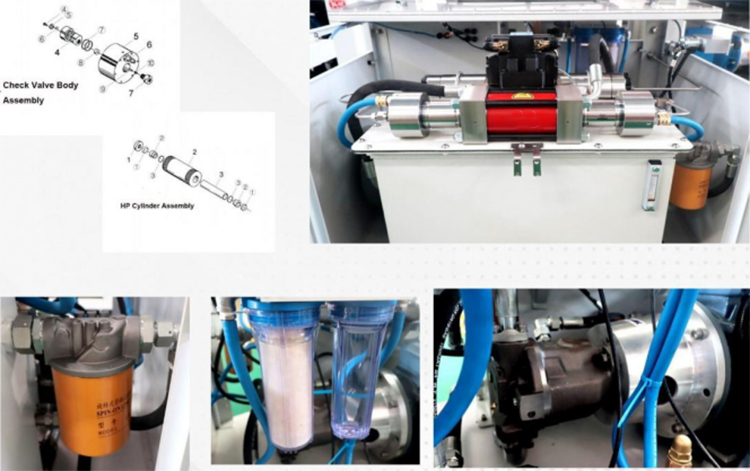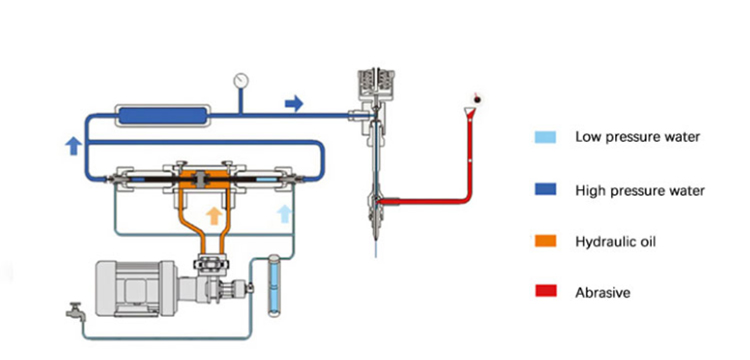Industry-news
How Does a Waterjet Intensifier Pump Work and How to Maintain It?
How Does a Waterjet Intensifier Pump Work and How to Maintain It?

Waterjet cutting is a versatile and precise method used in industries such as manufacturing, aerospace, automotive, and stone fabrication. At the heart of this cutting process lies the waterjet intensifier pump, a vital component responsible for generating the ultra-high pressure required for cutting various materials. In this article, we’ll explore how a waterjet intensifier pump works, its role in cutting different materials, and essential maintenance tips to keep it running efficiently.
How Does a Waterjet Intensifier Pump Work?


The waterjet intensifier pump generates the extremely high pressure needed to force water through a small orifice, creating a focused jet capable of cutting a wide range of materials. Here’s a step-by-step explanation of its working principle:
1. Low-Pressure Water Input
The pump begins by drawing water from a low-pressure source, typically at pressures around 60-80 psi.
2. Intensifier System
The intensifier uses a hydraulic system to amplify the pressure of the water. This is achieved using a hydraulic cylinder and a reciprocating piston.
- Hydraulic Cylinder: The cylinder is driven by hydraulic oil, which exerts force on the piston.
- Reciprocating Piston: The piston compresses the water, raising its pressure to levels as high as 60,000 psi (approximately 4,137 bar) or more.
3. High-Pressure Water Output
The high-pressure water is then directed through high-pressure tubing to the cutting head, where it passes through a small orifice to create a concentrated jet of water.
4. Abrasive Mixing (Optional)
For cutting hard materials like metal, stone, and glass, an abrasive material such as garnet is introduced into the high-pressure water stream. This combination increases the cutting power, allowing it to slice through tough materials.
Cutting Different Materials with a Waterjet
Waterjet cutting is known for its ability to handle a diverse range of materials. The intensifier pump plays a crucial role in delivering consistent pressure to achieve clean and precise cuts. Below are some common materials and their cutting speeds and effects:
1. Metals
- Steel (Mild and Stainless): Steel is cut efficiently with a waterjet. Thinner sheets (e.g., 6mm) can be cut quickly, while thicker sheets (e.g., 25mm or more) require slower speeds. The cut edges are smooth with no heat-affected zones (HAZ).
- Aluminum: Due to its softness, aluminum can be cut faster than steel. The cutting speed depends on thickness but typically ranges from 30-60 mm/min for thicker plates.
- Titanium: Waterjet cutting is ideal for titanium, producing clean, burr-free edges. However, the cutting speed is slower due to its hardness.
2. Stone and Ceramics
- Granite and Marble: Waterjets cut through stone at moderate speeds, achieving smooth edges with minimal chipping.
- Ceramics: These are cut at slower speeds to prevent cracking, resulting in precise cuts for tiles or industrial components.
3. Glass
- Tempered Glass: While standard glass is easily cut, tempered glass cannot be cut as it shatters under stress. For non-tempered glass, waterjets achieve clean and precise cuts at moderate speeds.
4. Plastics
- Acrylic and Polycarbonate: These materials are cut quickly with a waterjet, producing smooth edges without melting or discoloration.
5. Wood and Composites
- Natural Wood and MDF: Waterjet cutting produces clean edges with no burning, unlike laser cutting. Thicker wood requires slower speeds for a precise cut.
- Carbon Fiber: This material is cut at slower speeds, achieving clean edges without delamination.
6. Fabrics and Rubber
- Textiles and Gaskets: Waterjets can quickly cut intricate patterns in fabrics and rubber, leaving clean edges with no fraying or distortion.
How to Maintain a Waterjet Intensifier Pump
Regular maintenance of the waterjet intensifier pump is crucial to ensure optimal performance, reduce downtime, and extend the lifespan of the machine. Here are essential maintenance tips:
1. Monitor and Replace Seals
- Why: High-pressure seals are critical for maintaining consistent pressure and preventing leaks.
- When: Inspect seals weekly or after a set number of operating hours. Replace worn seals immediately to avoid pressure loss or damage to other components.
2. Check Hydraulic Oil Levels
- Why: The hydraulic system relies on oil to drive the piston. Low oil levels can lead to reduced performance and increased wear.
- When: Check the oil level daily and replace it according to the manufacturer’s recommendations.
3. Inspect High-Pressure Tubing
- Why: High-pressure tubing carries water at extreme pressures, making it prone to wear or damage.
- When: Inspect tubing regularly for leaks or cracks and replace it as needed.
4. Replace the Orifice
- Why: The orifice, made of sapphire or diamond, is subject to wear from high-pressure water and abrasive particles. A worn orifice reduces cutting precision.
- When: Replace the orifice based on cutting hours or if cutting quality declines.
5. Clean Filters and Screens
- Why: Filters and screens prevent debris from entering the system, protecting the pump and cutting head.
- When: Clean or replace filters and screens weekly to maintain optimal flow and prevent clogs.
6. Maintain the Check Valves
- Why: Check valves ensure water flows in the correct direction. Faulty valves can disrupt pressure and damage the pump.
- When: Inspect check valves monthly and replace them if they show signs of wear.
7. Perform Regular System Inspections
- Why: Identifying issues early prevents costly repairs and downtime.
- When: Conduct a full system inspection every 6 months, checking for wear, leaks, and proper alignment of all components.
Conclusion
The waterjet intensifier pump is a critical component of the Waterjet Cutting System, responsible for delivering the high pressure needed to cut a wide variety of materials. By understanding its operation and maintaining it properly, manufacturers can ensure consistent cutting performance, extend the pump’s lifespan, and minimize downtime.
Whether cutting metals, stone, plastics, or composites, the waterjet intensifier pump enables precise and efficient results, making it an indispensable tool in modern manufacturing. Regular maintenance, such as monitoring seals, replacing the orifice, and checking hydraulic oil, will keep your waterjet system running smoothly and delivering high-quality cuts for years to come.





